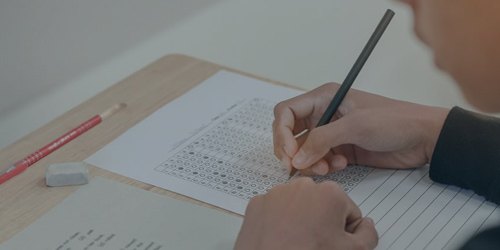BITSAT 2022 Syllabus:
The syllabus is based on the NCERT books of the 11th and 12th classes. The questions of sections are from different topics such as Physics, Chemistry, English Proficiency, Logical Reasoning, Mathematics, and Biology. Candidates can prepare from NCERT textbooks. Candidates must carefully go through their class 11 and 12 syllabi of Physics, Chemistry, and Mathematics. 40 questions are asked from Physics and Chemistry while 45 questions will be put up from Mathematics/Biology, English 15 questions and logical reasoning 10.
- To prepare and perform better in BITSAT 2022 test.
- These mock tests are set on the pattern followed by BITSAT 2022.
- Candidates can attempt them to analyze their preparation and performance.
- It is important to solve mock tests and sample papers beforehand to analyze the level of preparation and areas that need improvement.
- You can get the sample mock tests below.
- Mock Test- I
- Mock Test- II
- Mock Test- III
- Mock Test- IV
- Mock Test- V
- Mock Test- VI
- Mock Test- VII
- Mock Test- VIII
Detailed Syllabus for BITSAT 2022:
Physics:
| Units | Topics |
|---|---|
| Units & Measurement |
- Units (Different systems of units, SI units, fundamental and derived units) - Dimensional Analysis - Precision and significant figures - Fundamental measurements in Physics (Vernier calipers, screw gauge, Physical balance, etc) |
| Kinematics |
- Properties of vectors - Position, velocity and acceleration vectors - Motion with constant acceleration - Projectile motion - Uniform circular motion - Relative motion |
| Newton’s Laws of Motion |
- Newton’s laws (free body diagram, resolution of forces) - Motion on an inclined plane - The motion of blocks with pulley systems - Circular motion – centripetal force - Inertial and non-inertial frames |
| Impulse and Momentum |
- Definition of impulse and momentum - Conservation of momentum - Collisions - The momentum of a system of particles - Center of mass |
| Work and Energy |
- Work done by a force - Kinetic energy and work-energy theorem - Power - Conservative forces and potential energy - Conservation of mechanical energy |
| Rotational Motion |
- Description of rotation (angular displacement, angular velocity, and angular acceleration) - Rotational motion with constant angular acceleration - Moment of inertia, Parallel and perpendicular axes theorems, rotational kinetic energy - Torque and angular momentum - Conservation of angular momentum - Rolling motion |
| Gravitation |
- Newton’s law of gravitation - Gravitational potential energy, Escape velocity - The motion of planets – Kepler’s laws, satellite motion |
| Mechanics of Solids and Fluids |
- Elasticity - Pressure, density, and Archimedes’ principle - Viscosity and Surface Tension - Bernoulli’s theorem |
| Oscillations |
- Kinematics of simple harmonic motion - Spring mass system, simple and compound pendulum - Forced & damped oscillations, resonance |
| Waves |
- Progressive sinusoidal waves - Standing waves in strings and pipes - Superposition of waves, beats - Doppler Effect |
| Heat and Thermodynamics |
- kinetic theory of gases - Thermal equilibrium and temperature - Specific heat, Heat Transfer - Conduction, convection and radiation, thermal conductivity, Newton’s law of cooling Work, heat and the first law of thermodynamics - The second law of thermodynamics, Carnot engine – Efficiency and Coefficient of performance |
| Electrostatics |
- Coulomb’s law - Electric field (discrete and continuous charge distributions) - Electrostatic potential and Electrostatic potential energy - Gauss’ law and its applications - Electric dipole - Capacitance and dielectrics (parallel plate capacitor, capacitors in series and parallel) |
| Current Electricity | - Ohm’s law, Joule heating - DC circuits – Resistors and cells in series and parallel, Kirchoff’s laws, potentiometer, and Wheatstone bridge - Electrical Resistance (Resistivity, origin and temperature dependence of resistivity) |
| Magnetic Effect of Current |
- Biot-Savart’s law and its applications - Ampere’s law and its applications - Lorentz force, the force on current-carrying conductors in a magnetic field - The magnetic moment of a current loop, torque on a current loop, Galvanometer and its conversion to voltmeter and ammeter |
| Electromagnetic Induction |
- Faraday’s law, Lenz’s law, eddy currents - Self and mutual inductance - Transformers and generators - Alternating current (peak and RMS value) - AC circuits, LCR circuits |
| Optics |
- Laws of reflection and refraction - Lenses and mirrors - Optical instruments – telescope and microscope - Interference – Huygen’s principle, Young’s double-slit experiment - Interference in thin films - Diffraction due to a single slit - Electromagnetic waves and their characteristics (only qualitative ideas), Electromagnetic spectrum - Polarisation – states of polarization, Malus’ law, Brewster’s law |
| Modern Physics |
- Dual nature of light and matter – Photoelectric effect, De Broglie wavelength - Atomic models – Rutherford’s experiment, Bohr’s atomic model - Hydrogen atom spectrum - Radioactivity - Nuclear reactions : Fission and fusion, binding energy |
| Electronic Devices |
- Energy bands in solids (qualitative ideas only), conductors, insulators and semiconductors - Semiconductor diode – I-V characteristics in forward and reverse bias, diode as a rectifier; I-V characteristics of LED, photodiode, solar cell, and Zener diode; Zener diode as a voltage regulator - Junction transistor, transistor action, characteristics of a transistor; transistor as an amplifier (common emitter configuration) and oscillator - Logic gates (OR, AND, NOT, NAND and NOR). Transistor as a switch |
Chemistry:
| Unit | Topics |
|---|---|
| States of Matter |
- Measurement: Physical quantities and SI units, Dimensional analysis, Precision, Significant figures - Chemical reactions: Laws of chemical combination, Dalton’s atomic theory; Mole concept; Atomic, molecular and molar masses; Percentage composition empirical & molecular formula; Balanced chemical equations & stoichiometry - Three states of matter, intermolecular interactions, types of bonding, melting and boiling points Gaseous state: Gas Laws, ideal behavior, ideal gas equation, empirical derivation of gas equation, Avogadro number, Deviation from ideal behaviour – Critical temperature, Liquefaction of gases, van der Waals equation - Liquid state: Vapour pressure, surface tension, viscosity - Solid state: Classification; Space lattices & crystal systems; Unit cell in two dimensional and three dimensional lattices, calculation of density of unit cell – Cubic & hexagonal systems; Close packing; Crystal structures: Simple AB and AB2 type ionic crystals, covalent crystals – diamond & graphite, metals. Voids, number of atoms per unit cell in a cubic unit cell, Imperfections- Point defects, non-stoichiometric crystals; Electrical, magnetic and dielectric properties; Amorphous solids – qualitative description. Band theory of metals, conductors, semiconductors and insulators, and n- and p- type semiconductors |
| Atomic Structure |
- Introduction: Subatomic particles; Atomic number, isotopes and isobars, Thompson’s model and its limitations, Rutherford’s picture of atom and its limitations; Hydrogen atom spectrum and Bohr model and its limitations - Quantum mechanics: Wave-particle duality – de Broglie relation, Uncertainty principle; Hydrogen atom: Quantum numbers and wavefunctions, atomic orbitals and their shapes (s, p, and d), Spin quantum number - Many electron atoms: Pauli exclusion principle; Aufbau principle and the electronic configuration of atoms, Hund’s rule |
| Periodicity | - Valence electrons, Ionic Bond: Lattice Energy and Born-Haber cycle; Covalent character of ionic bonds and polar character of covalent bond, bond parameters - Molecular Structure: Lewis picture & resonance structures, VSEPR model & molecular shapes - Covalent Bond: Valence Bond Theory- Orbital overlap, Directionality of bonds & hybridization (s, p & d orbitals only), Resonance; Molecular orbital theory- Methodology, Orbital energy level diagram, Bond order, Magnetic properties for homonuclear diatomic species (qualitative idea only) - Dipole moments; Hydrogen Bond |
| Thermodynamics |
- Basic Concepts: Systems and surroundings; State functions; Intensive & Extensive Properties; Zeroth Law and Temperature - First Law of Thermodynamics: Work, internal energy, heat, enthalpy, heat capacities and specific heats, measurements of ?U and ?H, Enthalpies of formation, phase transformation, ionization, electron gain; Thermochemistry; Hess’s Law, Enthalpy of bond dissociation, combustion, atomization, sublimation, solution and dilution - Second Law: Spontaneous and reversible processes; entropy; Gibbs free energy related to spontaneity and non-spontaneity, non-mechanical work; Standard free energies of formation, free energy change and chemical equilibrium - Third Law: Introduction |
| Physical and Chemical Equilibria |
- Concentration Units: Mole Fraction, Molarity, and Molality - Solutions: Solubility of solids and gases in liquids, Vapour Pressure, Raoult’s law, Relative lowering of vapor pressure, depression in freezing point; elevation in boiling point; osmotic pressure, determination of molecular mass; solid solutions, abnormal molecular mass, van’t Hoff factor. Equilibrium: Dynamic nature of equilibrium, law of mass action - Physical Equilibrium: Equilibria involving physical changes (solid-liquid, liquid-gas, solid-gas), Surface chemistry, Adsorption, Physical and Chemical adsorption, Langmuir Isotherm, Colloids and emulsion, classification, preparation, uses - Chemical Equilibria: Equilibrium constants (KP, KC), Factors affecting equilibrium, Le- Chatelier’s principle - Ionic Equilibria: Strong and Weak electrolytes, Acids and Bases (Arrhenius, Lewis, Lowry and Bronsted) and their dissociation; degree of ionization, Ionization of Water; ionization of polybasic acids, pH; Buffer solutions; Henderson equation, Acid-base titrations; Hydrolysis; Solubility Product of Sparingly Soluble Salts; Common Ion Effect - Factors Affecting Equilibria: Concentration, Temperature, Pressure, Catalysts, Significance of ?G and ?G0 in Chemical Equilibria |
| Electrochemistry |
- Redox Reactions: Oxidation-reduction reactions (electron transfer concept); Oxidation number; Balancing of redox reactions; Electrochemical cells and cell reactions; Standard electrode potentials; EMF of Galvanic cells; Nernst equation; Factors affecting the electrode potential; Gibbs energy change and cell potential; Secondary cells; dry cells, Fuel cells; Corrosion and its prevention - Electrolytic Conduction: Electrolytic Conductance; Specific and molar conductivities; variations of conductivity with concentration , Kolhrausch’s Law and its application, Electrolysis, Faraday’s laws of electrolysis; Electrode potential and electrolysis, Commercial production of the chemicals, NaOH, Na, Al |
| Chemical Kinetics |
- Aspects of Kinetics: Rate and Rate expression of a reaction; Rate constant; Order and molecularity of the reaction; Integrated rate expressions and half-life for zero and first-order reactions - Factor Affecting the Rate of the Reactions: Concentration of the reactants, catalyst; the size of particles, the Temperature dependence of rate constant concept of collision theory (elementary idea, no mathematical treatment); Activation energy - Surface Chemistry: Adsorption – physisorption and chemisorption; factors affecting adsorption of gasses on solids; catalysis: homogeneous and heterogeneous, activity and selectivity: enzyme catalysis, colloidal state: the distinction between true solutions, colloids, and suspensions; lyophilic, lyophobic multimolecular and macromolecular colloids; properties of colloids; Tyndall effect, Brownian movement, electrophoresis, coagulation; emulsions–types of emulsions |
| Hydrogen and s-block elements |
- Hydrogen: Element: unique position in the periodic table, occurrence, isotopes; Dihydrogen: preparation, properties, reactions, and uses; Molecular, saline, ionic, covalent, interstitial hydrides; Water: Properties; Structure and aggregation of water molecules; Heavy water; Hydrogen peroxide: preparation, reaction, structure & use, Hydrogen as a fuel - S-block elements: Abundance and occurrence; Anomalous properties of the first elements in each group; diagonal relationships; trends in the variation of properties (ionization energy, atomic & ionic radii) - Alkali metals: Lithium, sodium, and potassium: occurrence, extraction, reactivity, and electrode potentials; Biological importance; Reactions with oxygen, hydrogen, halogens water; Basic nature of oxides and hydroxides; Halides; Properties and uses of compounds such as NaCl, Na2CO3, NaHCO3, NaOH, KCl, and KOH - Alkaline earth metals: Magnesium and calcium: Occurrence, extraction, reactivity and electrode potentials; Reactions with O2, H2O, H2, and halogens; Solubility and thermal stability of oxo salts; Biological importance of Ca and Mg; Preparation, properties, and uses of important compounds such as CaO, Ca(OH)2, plaster of Paris, MgSO4, MgCl2, CaCO3, and CaSO4 |
| p, d, and f-block elements |
- General: Abundance, distribution, physical and chemical properties, isolation and uses of elements; Trends in chemical reactivity of elements of a group; electronic configuration, oxidation states; anomalous properties of the first element of each group - Group 13 elements: Boron; Properties and uses of borax, boric acid, boron hydrides & halides. The reaction of aluminum with acids and alkalis - Group 14 elements: Carbon: carbon catenation, physical & chemical properties, uses, allotropes (graphite, diamond, fullerenes), oxides, halides and sulfides, carbides; Silicon: Silica, silicates, silicone, silicon tetrachloride, Zeolites, and their uses - Group 15 elements: Dinitrogen; Preparation, reactivity and uses of nitrogen; Industrial and biological nitrogen fixation; Compound of nitrogen; Ammonia: Haber’s process, properties and reactions; Oxides of nitrogen and their structures; Properties and Ostwald’s process of nitric acid production; Fertilizers – NPK type; Production of phosphorus; Allotropes of phosphorus; Preparation, structure, and properties of hydrides, oxides, oxoacids (elementary idea only) and halides of phosphorus, phosphine - Group 16 elements: Isolation and chemical reactivity of dioxygen; Acidic, basic, and amphoteric oxides; Preparation, structure, and properties of ozone; Allotropes of sulfur; Preparation/production properties and uses of sulfur dioxide and sulphuric acid; Structure and properties of oxides, oxoacids (structures only) - Group 17 and group 18 elements: Structure and properties of hydrides, oxides, oxoacids of halogens (structures only); preparation, properties & uses of chlorine & HCl; Inter halogen compounds; Bleaching Powder; Uses of Group 18 elements, Preparation, structure, and reactions of xenon fluorides, oxides, and oxoacids - d-Block elements: General trends in the chemistry of first-row transition elements; Metallic character; Oxidation state; ionization enthalpy; Ionic radii; Color; Catalytic properties; Magnetic properties; Interstitial compounds; Occurrence and extraction of iron, copper, silver, zinc, and mercury; Alloy formation; Steel and some important alloys; preparation and properties of K2Cr2O7, KMnO4 - f-Block elements: Lanthanoids and actinoids; Oxidation states and chemical reactivity of lanthanoids compounds; Lanthanide contraction and its consequences, Comparison of actinoids and lanthanoids - Coordination Compounds: Coordination number; Ligands; Werner’s coordination theory; IUPAC nomenclature; Application and importance of coordination compounds (in qualitative analysis, extraction of metals and biological systems e.g. chlorophyll, vitamin B12, and hemoglobin); Bonding: Valence-bond approach, Crystal field theory (qualitative); Isomerism including stereoisomerism |
| Principles of Organic Chemistry and Hydrocarbons |
- Classification: General Introduction, classification based on functional groups, trivial and IUPAC nomenclature. Methods of purification: qualitative and quantitative - Electronic displacement in a covalent bond: Inductive, resonance effects, and hyperconjugation; free radicals; carbocations, carbanions, nucleophiles and electrophiles; types of organic reactions, free radial halogenations - 10.3 Alkanes: Structural isomerism, general properties, and chemical reactions, free medical halogenation, combustion, and pyrolysis - Alkenes and alkynes: General methods of preparation and reactions, physical properties, electrophilic and free radical additions, acidic character of alkynes and (1,2 and 1,4) addition to dienes - Aromatic hydrocarbons: Sources; properties; isomerism; resonance delocalization; aromaticity; polynuclear hydrocarbons; IUPAC nomenclature; mechanism of electrophilic substitution reaction, directive influence and effect of substituents on reactivity; carcinogenicity and toxicity - Haloalkanes and haloarenes: Physical properties, nomenclature, optical rotation, chemical reactions and mechanism of substitution reaction. Uses and environmental effects; di, tri, tetrachloromethane, iodoform, freon, and DDT |
| Stereochemistry |
- Conformations: Ethane conformations; Newman and Sawhorse projections - Geometrical isomerism in alkenes |
| Organic Compounds with Functional Groups Containing Oxygen and Nitrogen |
- General: Nomenclature, electronic structure, important methods of preparation, identification, important reactions, physical and chemical properties, uses of alcohols, phenols, ethers, aldehydes, ketones, carboxylic acids, nitro compounds, amines, diazonium salts, cyanides and isocyanides - Specific: Reactivity of -hydrogen in carbonyl compounds, effect of substituents on alpha- carbon on acid strength, comparative reactivity of acid derivatives, mechanism of nucleophilic addition and dehydration, the basic character of amines, methods of preparation, and their separation, importance of diazonium salts in synthetic organic chemistry |
| Biological , Industrial and Environmental chemistry |
- Carbohydrates: Classification; Monosaccharides; Structures of pentoses and hexoses; Simple chemical reactions of glucose, Disaccharides: reducing and non-reducing sugars – sucrose, maltose and lactose; Polysaccharides: elementary idea of structures of starch, cellulose and glycogen - Proteins: Amino acids; Peptide bond; Polypeptides; Primary structure of proteins; Simple idea of secondary , tertiary and quarternary structures of proteins; Denaturation of proteins and enzymes - Nucleic Acids: Types of nucleic acids; Primary building blocks of nucleic acids (chemical composition of DNA & RNA); Primary structure of DNA and its double helix; Replication; Transcription and protein synthesis; Genetic code - Vitamins: Classification, structure, functions in biosystems; Hormones - Polymers: Classification of polymers; General methods of polymerization; Molecular mass of polymers; Biopolymers and biodegradable polymers; methods of polymerization (free radical, cationic and anionic addition polymerizations); Copolymerization: Natural rubber; Vulcanization of rubber; Synthetic rubbers. Condensation polymers - Pollution: Environmental pollutants; soil, water and air pollution; Chemical reactions in atmosphere; Smog; Major atmospheric pollutants; Acid rain; Ozone and its reactions; Depletion of ozone layer and its effects; Industrial air pollution; Green house effect and global warming; Green Chemistry, study for control of environmental pollution - Chemicals in medicine, health-care and food: Analgesics, Tranquilizers, antiseptics, disinfectants, anti-microbials, anti-fertility drugs, antihistamines, antibiotics, antacids; Preservatives, artificial sweetening agents, antioxidants, soaps and detergents |
| Theoretical Principles of Experimental Chemistry |
- Volumetric Analysis: Principles; Standard solutions of sodium carbonate and oxalic acid; Acid- base titrations; Redox reactions involving KI, H2SO4, Na2SO3, Na2S2O3 and H2S; Potassium permanganate in acidic, basic and neutral media; Titrations of oxalic acid, ferrous ammonium sulphate with KMnO4, K2 Cr2O7/Na2S2O3, Cu(II)/Na2S2O3 - Qualitative analysis of Inorganic Salts: Principles in the determination of the cations Pb2+, Cu2+, As3+, Mn2+, Al3+, Zn2+, Co2+, Ca2+, Sr2+, Ba2+, Mg2+, NH4+, Fe3+, Ni2+ and the anions CO32-, S2-, SO42-, SO32-, NO2-, NO3-, Cl-, Br-, I-, PO43-, CH3COO-, C2O42- - Physical Chemistry Experiments: preparation and crystallization of alum, copper sulphate. Benzoic acid ferrous sulphate, double salt of alum and ferrous sulphate, potassium ferric sulphate; Temperature vs. solubility; Study of pH charges by common ion effect in case of weak acids and weak bases; pH measurements of some solutions obtained from fruit juices, solutions of known and varied concentrations of acids, bases and salts using pH paper or universal indicator; Lyophilic and lyophobic sols; Dialysis; Role of emulsifying agents in emulsification. Equilibrium studies involving ferric and thiocyanate ions (ii) [Co(H2O)6]2+ and chloride ions; Enthalpy determination for strong acid vs. strong base neutralization reaction (ii) hydrogen bonding interaction between acetone and chloroform; Rates of the reaction between (i) sodium thiosulphate and hydrochloric acid, (ii) potassium iodate and sodium sulphite (iii) iodide vs. hydrogen peroxide, concentration and temperature effects in these reactions - Purification Methods: Filtration, crystallization, sublimation, distillation, differential extraction, and chromatography. Principles of melting point and boiling point determination; principles of paper chromatographic separation – Rf values - Qualitative Analysis of Organic Compounds: Detection of nitrogen, sulphur, phosphorous and halogens; Detection of carbohydrates, fats and proteins in foodstuff; Detection of alcoholic, phenolic, aldehydic, ketonic, carboxylic, amino groups and unsaturation - Quantitative Analysis of Organic Compounds: Basic principles for the quantitative estimation of carbon, hydrogen, nitrogen, halogen, sulphur and phosphorous; Molecular mass determination by silver salt and chloroplatinate salt methods; Calculations of empirical and molecular formulae - Principles of Organic Chemistry Experiments: Preparation of iodoform, acetanilide, p-nitro acetanilide, di-benzayl acetone, aniline yellow, beta-naphthol; Preparation of acetylene and study of its acidic character - Basic Laboratory Technique: Cutting glass tube and glass rod, bending a glass tube, drawing out a glass jet, boring of cork |
Mathematics:
| Unit | Topics |
|---|---|
| Algebra |
- Complex numbers, addition, multiplication, conjugation, polar representation, properties of modulus and principal argument, triangle inequality, roots of complex numbers, geometric interpretations; Fundamental theorem of algebra - Theory of Quadratic equations, quadratic equations in real and complex number system and their solutions - Arithmetic and geometric progressions, arithmetic, geometric and arithmetic-geometric series, sums of finite arithmetic and geometric progressions, infinite geometric series, sums of squares and cubes of the first n natural numbers - Logarithms and their properties - Exponential series - Permutations and combinations, Permutations as an arrangement and combination as selection, simple applications - Binomial theorem for a positive integral index, properties of binomial coefficients, Pascal’s triangle - Matrices and determinants of order two or three, properties and evaluation of determinants, addition and multiplication of matrices, adjoint and the inverse of matrices, Solutions of simultaneous linear equations in two or three variables, elementary row and column operations of matrices, types of matrices, applications of determinants in finding the area of triangles - Sets, Relations and Functions, algebra of sets applications, equivalence relations, mappings, one-one, into and onto mappings, the composition of mappings, binary operation, the inverse of a function, functions of real variables like polynomial, modulus, signum and greatest integer - Mathematical reasoning and methods of proofs, Mathematically acceptable statements. Connecting words/phrases – consolidating the understanding of “if and only if (necessary and sufficient) condition”, “implies”, “and/or”, “implied” by”, “and”, “our”, “there exists” and through variety of examples related to real life and Mathematics. Validating the statements involving the connecting words – the difference between contradiction, converse, and contrapositive. Mathematical induction - Linear Inequalities, solution of linear inequalities in one variable (Algebraic) and two variables (Graphical) |
| Trigonometry |
- Measurement of angles in radians and degrees, positive and negative angles, trigonometric ratios, functions with their graphs and identities - The solution of trigonometric equations - Inverse trigonometric functions |
| Two-dimensional Coordinate Geometry |
- Cartesian coordinates, the distance between two points, section formulae, the shift of origin. - Straight lines and pair of straight lines: Equation of straight lines in various forms, the angle between two lines, the distance of a point from a line, lines through the point of intersection of two given lines, equation of the bisector of the angle between two lines, concurrent lines. - Circles: Equation of a circle in standard form, parametric equations of a circle. - Conic sections: parabola, ellipse, and hyperbola their eccentricity, directrices & foci. |
| Three-dimensional Coordinate Geometry |
- Co-ordinate axes and co-ordinate planes, the distance between two points, section formula, direction cosines and direction ratios, equation of a straight line in space and skew lines. - The angle between two lines whose direction ratios are given, the shortest distance between two lines. - Equation of a plane, the distance of a point from a plane, condition for coplanarity of three lines, angles between two planes, the angle between a line and a plane. |
| Differential calculus |
- Domain and range of a real-valued function, Limits, and Continuity of the sum, difference, product, and quotient of two functions, Differentiability. - The derivative of different types of functions (polynomial, rational, trigonometric, inverse trigonometric, exponential, logarithmic, implicit functions), the derivative of the sum, difference, product and quotient of two functions, chain rule, parametric form. - Geometric interpretation of derivative, Tangents and Normal. - Increasing and decreasing functions, Maxima and minima of a function. - Rolle’s Theorem, Mean Value Theorem and Intermediate Value Theorem. |
| Integral calculus |
- Integration as the inverse process of differentiation, indefinite integrals of standard functions. - Methods of integration: Integration by substitution, Integration by parts, integration by partial fractions, and integration by trigonometric identities. - Definite integrals and their properties, Fundamental Theorem of Integral Calculus, applications in finding areas under simple curves. - Application of definite integrals to the determination of areas of regions bounded by simple curves. |
| Ordinary Differential Equations |
- Order and degree of a differential equation, formulation of a differential equation whole general solution is given, variables separable method. - The solution of homogeneous differential equations of the first order and first degree - Linear first-order differential equations |
| Probability |
- Various terminology in probability, axiomatic and other approaches of probability, addition and multiplication rules of probability. - Conditional probability, total probability, and Baye’s theorem - Independent events - Discrete random variables and distributions with mean and variance. |
| Vectors |
- Direction ratio/cosines of vectors, the addition of vectors, scalar multiplication, and the position vector of a point dividing a line segment in a given ratio. - Dot and cross products of two vectors, projection of a vector on a line. - Scalar triple products and their geometrical interpretations. |
| Statistics |
- Measures of dispersion - Analysis of frequency distributions with equal means but different variances |
| Linear Programming |
- Various terminology and formulation of linear Programming - The solution of linear Programming using graphical method, feasible and infeasible regions, feasible and infeasible solutions, optimal feasible solutions (up to three nontrivial constraints) |
| Mathematical modeling | Formulation of a simple real-life problem, solution using matrices, calculus, and linear programming. |
English Proficiency:
| Unit | Topics |
|---|---|
| Grammar |
- The agreement, Time and Tense, Parallel construction, Relative pronouns - Determiners, Prepositions, Modals, Adjectives - Voice, Transformation - Question tags, Phrasal verbs |
| Vocabulary |
- Synonyms, Antonyms, Odd Word, One Word, Jumbled letters, Homophones, Spelling - Contextual meaning. - Analogy |
| Reading Comprehension |
- Content/ideas - Vocabulary - Referents - Idioms/Phrases - Reconstruction (rewording) |
| Composition |
- Rearrangement - Paragraph Unity - Linkers/Connectives |
Logical Reasoning:
| Unit | Topic |
|---|---|
| Verbal Reasoning |
- Analogy: Analogy means correspondence. In the questions based on analogy, a particular relationship is given and another similar relationship has to be identified from the alternatives provided. - Classification: Classification means to assort the items of a given group on the basis of certain common qualities they possess and then spot the odd option out. - Series Completion: Here series of numbers or letters are given and one is asked to either complete the series or find out the wrong part in the series. - Logical Deduction: Reading Passage: Here a brief passage is given and based on the passage the candidate is required to identify the correct or incorrect logical conclusions. - Chart Logic: Here a chart or a table is given that is partially filled in and asks to complete it in accordance with the information given either in the chart/table or in the question. |
| Nonverbal Reasoning |
- Pattern Perception: Here a certain pattern is given and generally a quarter is left blank. The candidate is required to identify the correct quarter from the given four alternatives. - Figure Formation and Analysis: The candidate is required to analyze and form a figure from various given parts. - Paper Cutting: It involves the analysis of a pattern that is formed when a folded piece of paper is cut into a definite design. - Figure Matrix: In this, more than one set of figures is given in the form of a matrix, all of them following the same rule. The candidate is required to follow the rule and identify the missing figure. - Rule Detection: Here a particular rule is given and it is required to select from the given sets of figures, a set of figures, which obeys the rule and forms the correct series. |
Biology:
| Unit | Topic |
|---|---|
| Diversity in Living World |
- Biology – it's meaning and relevance to mankind - What is living; Taxonomic categories and aids; Systematics and Binomial system of nomenclature. - Introductory classification of living organisms (Two-kingdom system, Five-kingdom system) - Plant kingdom – Salient features of major groups (Algae to Angiosperms) - Animal kingdom – Salient features of Nonchordates up to phylum, and Chordates up to class level. |
| Cell: The Unit of Life; Structure and Function |
- Cell wall; Cell membrane; Endomembrane system (ER, Golgi apparatus/Dictyosome, Lysosomes, Vacuoles); Mitochondria; Plastids; Ribosomes; Cytoskeleton; Cilia and Flagella; Centrosome and Centriole; Nucleus; Microbodies. - Structural differences between prokaryotic and eukaryotic, and between plant and animal cells. - Cell cycle (various phases); Mitosis; Meiosis. - Biomolecules – Structure and function of Carbohydrates, Proteins, Lipids, and Nucleic acids. - Enzymes – Chemical nature, types, properties and mechanism of action. |
| Genetics and Evolution |
- Mendelian inheritance; Chromosome theory of inheritance; Gene interaction; Incomplete dominance; Co-dominance; Complementary genes; Multiple alleles - Linkage and Crossing over; Inheritance patterns of hemophilia and blood groups in humans - DNA –its organization and replication; Transcription and Translation - Gene expression and regulation; DNA fingerprinting - Theories and evidence of evolution, including modern Darwinism |
| Structure and Function – Plants |
- Morphology of a flowering plant; Tissues and tissue systems in plants; Anatomy and function of the root, stem (including modifications), leaf, inflorescence, flower (including position and arrangement of different whorls, placentation), fruit and seed; Types of fruit; Secondary growth - Absorption and movement of water (including diffusion, osmosis and water relations of the cell) and of nutrients; Translocation of food; Transpiration and gaseous exchange; Mechanism of stomatal movement - Mineral nutrition – Macro- and micro-nutrients in plants including deficiency disorders; Biological nitrogen fixation mechanism - Photosynthesis – Light reaction, cyclic and non-cyclic photophosphorylation; various pathways of carbon dioxide fixation; Photorespiration; Limiting factors - Respiration – Anaerobic, Fermentation, Aerobic; Glycolysis, TCA cycle; Electron transport system; Energy relations |
| Structure and Function - Animals |
- Human Physiology – Digestive system – organs, digestion and absorption; Respiratory system – organs, breathing and exchange and transport of gases - Body fluids and circulation – Blood, lymph, double circulation, regulation of cardiac activity; Hypertension, Coronary artery diseases - Excretion system – Urine formation, regulation of kidney function - Locomotion and movement – Skeletal system, joints, muscles, types of movement - Control and co-ordination – Central and peripheral nervous systems, structure and function of a neuron, reflex action, and sensory reception; Role of various types of endocrine glands; Mechanism of hormone action |
| Reproduction, Growth, and Movement in Plants |
- Asexual methods of reproduction - Sexual Reproduction – Development of male and female gametophytes; Pollination (Types and agents); Fertilization; Development of embryo, endosperm, seed, and fruit (including parthenocarpy and helminth) - Growth and Movement – Growth phases; Types of growth regulators and their role in seed dormancy, germination and movement - Apical dominance; Senescence; Abscission; Photoperiodism; Vernalisation - Various types of movements |
| Reproduction and Development in Humans |
- Male and female reproductive systems - Menstrual cycle; Gamete production; Fertilisation; Implantation - Embryo development - Pregnancy and parturition - Birth control and contraception |
| Ecology and Environment |
- Meaning of ecology, environment, habitat, and niche - Ecological levels of organization (organism to biosphere); Characteristics of Species, Population, Biotic Community and Ecosystem; Succession and Climax. Ecosystem – Biotic and abiotic components; Ecological pyramids; Food chain and Food web - Energy flow; Major types of ecosystems including agroecosystem - Ecological adaptations – Structural and physiological features in plants and animals of aquatic and desert habitats - Biodiversity and Environmental Issues – Meaning, types, and conservation strategies (Biosphere reserves, National parks, and Sanctuaries), Air and Water Pollution (sources and major pollutants); Global warming and Climate change; Ozone depletion; Noise pollution; Radioactive pollution; Methods of pollution control (including an idea of bioremediation); Deforestation; Extinction of species (Hot Spots). |
| Biology and Human Welfare |
- Animal husbandry – Livestock, Poultry, Fisheries; Major animal diseases and their control. Pathogens of major communicable diseases of humans caused by fungi, bacteria, viruses, protozoans, and helminths, and their control - Cancer; AIDS - Adolescence and drug/alcohol abuse -Basic concepts of immunology - Plant Breeding and Tissue Culture in crop improvement |
| Biotechnology and its Applications |
- Microbes as an ideal system for biotechnology - Microbial technology in food processing, industrial production (alcohol, acids, enzymes, antibiotics), sewage treatment and energy generation - Steps in recombinant DNA technology – restriction enzymes, NA insertion by vectors and other methods, regeneration of recombinants - Applications of R-DNA technology in human health –Production of Insulin, Vaccines and Growth hormones, Organ transplant, Gene therapy - Applications in Industry and Agriculture – Production of expensive enzymes, strain improvement to scale up bioprocesses, GM crops by transfer of genes for nitrogen fixation, herbicide-resistance, and pest-resistance including Bt crops |











